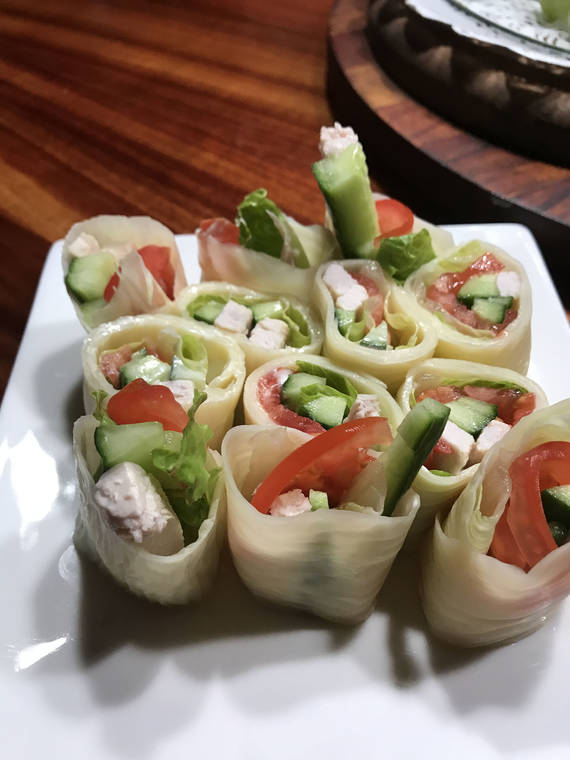Let’s Talk Food: First food thoughts for a new year

Courtesy of AUDREY WILSON Local tangerines and bananas.

Courtesy of AUDREY WILSON Fruit and vegetables from OK Farms.

Courtesy of AUDREY WILSON A plate lunch, which includes a green salad, from a local restaurant.

Courtesy of AUDREY WILSON Vegetables in a one-dish bowl meal.

Courtesy of AUDREY WILSON Vegetable wraps for snacks.

Courtesy of AUDREY WILSON Fruits, such as grapes, are great snacks or with a meal. One cup of grapes has only 62 calories; 176 mg of potassium; vitamins A, B-6, C and D; calcium; iron; and magnesium.
New Year’s resolutions are difficult, as we often say we will do it but by the end of January we have not fulfilled it and will probably forget about it. We need to make realistic ones that fit into our lifestyle and will not set us up for failure.
New Year’s resolutions are difficult, as we often say we will do it but by the end of January we have not fulfilled it and will probably forget about it. We need to make realistic ones that fit into our lifestyle and will not set us up for failure.
EAT FIVE FRUITS AND VEGETABLES A DAY
ADVERTISING
If you keep this thought in the back of your head and remember to eat at least five fruits/vegetables a day, you will feel guilty if you did not accomplish this by the end of the day.
Start your day with fruit at breakfast. Living in Hawaii, half a papaya is a good start. If you do not like papaya because of the smell, then pineapple or slices of apple work. A serving of fruit would be about 4-6 ounces for an adult. Fruit juice lacks the dietary fiber of the fruit, so it can count as one serving, but only one serving per day as permitted. You would need to eat a salad and fruit for lunch and a salad and fruit at dinner to get your five servings for the day.
Apples are in season right now and make a great snack, are good in a salad or fine just eaten with a meal. They are at their best now, as they were probably picked in November. When I fix a meal for my grandchildren, I try to have two servings, one of fruit and another of vegetable, in their three-compartment plates.
Apples are a good source of dietary fiber (about 4 grams per medium apple), Vitamin C and potassium.
My grandchildren love grapes, especially green ones. Right now, the green ones are especially sweet with a nice crunch. I always have them available for them as they like to put two in their mouths and pretend they are chipmunks.
One cup of grapes has only 62 calories; 176 mg of potassium; vitamins A, B-6, C and D; calcium; iron; and magnesium.
Carrots have only a couple of seasons, but thanks to cold storage they are available year round. If grated finely, kids will eat them, but if not, cooked carrots are a good alternative. Although you do lose some nutrients when you cook carrots, 1 cup has nearly 5 grams of dietary fiber, vitamins C and D, calcium, potassium and phosphorus.
Having the children plant seeds to grow their own vegetables will sometimes help to make them eat them. They like to feel they have something to do with the growing, and it piques their curiosity.
My challenge now is to get the grandchildren to eat a green salad. The 2-year-old will eat a few leaves of lettuce but the 5-year-old has not yet acquired the taste for green yet.
TRY A NEW INGREDIENT OR A NEW RECIPE
My love for food and cooking has taken me to cooking classes in Chiangmai, Thailand; Florence and Sorrento, Italy; Kerala, India; Oaxaca, Mexico; and New Orleans. What is so intriguing is the use of various spices and herbs to make their dishes.
In Thailand, nam pla is used instead of salt for flavoring, and chili peppers are important ingredients in many dishes. Using the freshest, in-season ingredients as well as garlic is a must in Italian cuisine. A combination of many spices and an exotic spice called hing, or asafoetida, is used to create wonderful Indian dishes. The complexity of making mole with several chilies, fresh and dried, produced the most delicious Mexican food I have ever eaten. And there is a method of making a roux for many Cajun and Creole dishes. These were all wonderful food experiences for me.
One interesting spice, hing, comes from the resin of giant fennel plants that grow in the wild in Afghanistan and Iran. The resin is dried and ground into a powder. It has a strong odor like a combination of garlic and onion. It is used by some practicing a religion that does not allow the use of garlic or onion. The smell is so strong that Island Naturals has the hing in a special container. It is used as a medicine in Ayurvedic medicine to aid in digestion, treat bronchitis and kidney stones.
As integral as hing is to the cuisine and medicine, it is interesting that India, only in October last year, planted 800 saplings of “ferula asafoetida” in the cold desert region of Lahaul and Spiti, India.
SUPPORT YOUR LOCAL RESTAURANT
We have had to stay at home and cook during the pandemic, which I hope will get better in a few months. Many of you have told me that you are tired of cooking for the family three meals a day, everyday! I love to cook, but every once in a while I, too, wish to have someone else’s cooking. Supporting our local restaurants during these times is important for their survival. If we don’t, many cannot survive.
Email Audrey Wilson at audreywilson808@gmail.com.


